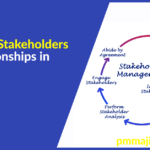Stakeholders are defined as anyone with an interest in, or who will be affected by, the successful completion of the project. In Scrum, they are external to the product team, and are represented by the Product Owner.
Stakeholders are the reason that products are created. They have wants and needs that need to be satisfied by the project team. Their wants and needs however are not always clear, indeed, the Stakeholder may not know exactly what they want, and as such, there are often numerous meetings to achieve a clear understanding for both parties.
The main Stakeholders of a project include:
Customers
Customers may be individuals or other organisations who obtain the products or services. They can be internal or external depending on the project.
Users
Users are the individuals who use the product or service. Like customers, they can also be internal or external, and are often the same person.
Sponsor
The organisation or individual who provides resources and support for the project is the Project Sponsor. They occupy the highest position in the process and have overall accountability for the outcome.
Stakeholders should ensure that they have knowledge of agile processes to ensure that they understand how the project will be managed, when they will see progress, and what is expected of them to make the project a success.
Principles of stakeholder development
Engaging stakeholders is a key aspect of project management. Clear communication channels should be developed to allow effective collaboration and a greater chance of project success. There are five main techniques to achieve this:
Early involvement
Stakeholders should be involved in the process as early as possible. Inclusion in discussions about requirements and story mapping will ensure they feel involved in the process, and that their input is valued. Beginning this process at an early stage helps Stakeholders to understand that their engagement with the project is valuable and expected, setting a precedent for their involvement going forward.
Stakeholders should be used as much as possible at the beginning of the process to gain an understanding of product value and how the end product will be used.
Explain the benefits
Sometimes it can be difficult for Stakeholders to understand how they benefit from the product or service, particularly if they are not the end user. This lack of understanding can affect the Stakeholders engagement with the process. As such, the benefits to each Stakeholder should be communicated explicitly.
Inclusion in important discussions
Nothing makes a person feel more valued than being included in important, decision-making discussions. Despite the Product Owner making the final decision, Stakeholders are integral to the process. Product Owners make decisions based on a number of factors and trade-off decisions that are communicated to them by the Stakeholders. It is important therefore, that there is constant communication between the parties.
Release planning collaboration
Release planning involves creating an outline that the team will work towards for the next release. Collaborating with Stakeholders at this stage aids discussions about dependencies, value delivery, risks and priorities and ensures that they feel engaged with each subsequent release in the process.
Gather feedback
Feedback from Stakeholders is invaluable so ensure that they are included in sprint reviews. In addition to gaining key feedback, inclusion in reviews assures Stakeholders that their feedback is important and valued.
Good stakeholders are vital to the project process. Their wants and needs drive product development, and their feedback helps to fine tune both the product and process, leading to a successful outcome.






